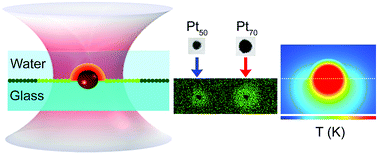Our official English website, www.x-mol.net, welcomes your feedback! (Note: you will need to create a separate account there.)
Platinum nanoparticles: a non-toxic, effective and thermally stable alternative plasmonic material for cancer therapy and bioengineering†
Nanoscale ( IF 6.7 ) Pub Date : 2018-04-25 00:00:00 , DOI: 10.1039/c8nr02275e Akbar Samadi 1, 2, 3, 4 , Henrik Klingberg 1, 2, 3, 4 , Liselotte Jauffred 1, 2, 3, 4 , Andreas Kjær 5, 6, 7, 8, 9 , Poul Martin Bendix 1, 2, 3, 4 , Lene B. Oddershede 1, 2, 3, 4
Nanoscale ( IF 6.7 ) Pub Date : 2018-04-25 00:00:00 , DOI: 10.1039/c8nr02275e Akbar Samadi 1, 2, 3, 4 , Henrik Klingberg 1, 2, 3, 4 , Liselotte Jauffred 1, 2, 3, 4 , Andreas Kjær 5, 6, 7, 8, 9 , Poul Martin Bendix 1, 2, 3, 4 , Lene B. Oddershede 1, 2, 3, 4
Affiliation

|
Absorption of near infrared (NIR) light by metallic nanoparticles can cause extreme heating and is of interest for instance in cancer treatment since NIR light has a relatively large penetration depth into biological tissue. Here, we quantify the extraordinary thermoplasmonic properties of platinum nanoparticles and demonstrate their efficiency in photothermal cancer therapy. Although platinum nanoparticles are extensively used for catalysis, they are much overlooked in a biological context. Via direct measurements based on a biological matrix we show that individual irradiated platinum nanoparticles with diameters of 50–70 nm can easily reach surface temperatures up to 900 K. In contrast to gold nanoshells, which are often used for photothermal purposes, we demonstrate that the platinum particles remain stable at these extreme temperatures. The experiments are paralleled by finite element modeling confirming the experimental results and establishing a theoretical understanding of the particles’ thermoplasmonic properties. At extreme temperatures it is likely that a vapor layer will form around the plasmonic particle, and we show this scenario to be consistent with direct measurements and simulations. Viability studies demonstrate that platinum nanoparticles themselves are non-toxic at therapeutically relevant concentrations, however, upon laser irradiation we show that they efficiently kill human cancer cells. Therefore, platinum nanoparticles are highly promising candidates for thermoplasmonic applications in the life sciences, in nano-medicine, and for bio-medical engineering.
中文翻译:

铂纳米颗粒:一种无毒,有效且热稳定的等离子体替代材料,用于癌症治疗和生物工程†
金属纳米粒子对近红外(NIR)光的吸收会导致极度发热,例如在癌症治疗中就引起了关注,因为NIR光对生物组织的穿透深度较大。在这里,我们量化了铂纳米粒子非凡的热等离子体性质,并证明了其在光热癌症治疗中的效率。尽管铂纳米颗粒广泛用于催化,但在生物学背景下却被大大忽略。通过基于生物基质的直接测量,我们发现直径为50-70 nm的单个辐照铂纳米粒子可以轻松达到900 K的表面温度。与经常用于光热目的的金纳米壳相反,我们证明了铂金颗粒在这些极端温度下保持稳定。通过有限元建模来平行进行实验,从而确认了实验结果并建立了粒子热等离子体特性的理论理解。在极端温度下,等离子体层周围可能会形成蒸汽层,我们证明这种情况与直接测量和模拟一致。可行性研究表明,铂纳米颗粒本身在治疗上相关的浓度下是无毒的,但是,在激光照射下,我们表明它们可以有效杀死人类癌细胞。因此,铂纳米粒子是生命科学,纳米医学和生物医学工程中热等离子体应用的极有前途的候选者。
更新日期:2018-04-25
中文翻译:

铂纳米颗粒:一种无毒,有效且热稳定的等离子体替代材料,用于癌症治疗和生物工程†
金属纳米粒子对近红外(NIR)光的吸收会导致极度发热,例如在癌症治疗中就引起了关注,因为NIR光对生物组织的穿透深度较大。在这里,我们量化了铂纳米粒子非凡的热等离子体性质,并证明了其在光热癌症治疗中的效率。尽管铂纳米颗粒广泛用于催化,但在生物学背景下却被大大忽略。通过基于生物基质的直接测量,我们发现直径为50-70 nm的单个辐照铂纳米粒子可以轻松达到900 K的表面温度。与经常用于光热目的的金纳米壳相反,我们证明了铂金颗粒在这些极端温度下保持稳定。通过有限元建模来平行进行实验,从而确认了实验结果并建立了粒子热等离子体特性的理论理解。在极端温度下,等离子体层周围可能会形成蒸汽层,我们证明这种情况与直接测量和模拟一致。可行性研究表明,铂纳米颗粒本身在治疗上相关的浓度下是无毒的,但是,在激光照射下,我们表明它们可以有效杀死人类癌细胞。因此,铂纳米粒子是生命科学,纳米医学和生物医学工程中热等离子体应用的极有前途的候选者。



























 京公网安备 11010802027423号
京公网安备 11010802027423号